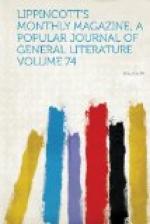We went then to see the old theatre, where plays used to be performed on great occasions. It was a large circle of stone wall, a miniature of the old amphi-theatre of the Roman Forum, with the sky for a roof. But now a vegetable-garden grows where the spectacle once was seen, and along the walls where the audience sat and gazed deep-hued wallflowers bloom and delicate jasmine-vines hang out their white stars.
Farther on is an old city-gate, which, unfortunately, was to be torn down to make way for a new road. Those gates are veritable pictures, with their beautiful round arches and the niche with its fresco underneath. This porta preserved perfectly in the crimson stone the smooth slide down which the suspended gate slipped at night or in times of danger.
Returning through the piazza, I saw the balcony of a public building draped with red satin, and a flag hung out in it. While this flag was out, Count B—— said, no creature which was sold could be returned to the seller, no matter what flaw might be discovered in it after the bargain was concluded. It was then the time to get rid of women-hating cows and oxen and “made-up” horses.
In the afternoon we went to the church of St. Francis to see the piccola ruota of the Neapolitan peasants, which is apparently a rehearsal for the gran ruota to be performed in the Porziuncola the day following. These people were all gone, when we reached the church, to follow a relic-bearing procession of Franciscans to the little chapel built over the spot where St. Francis was born, and the spectators took advantage of the opportunity to range themselves about the walls and wherever they could find places. We were scarcely in the seats offered us in the choir when a murmur of subdued exclamations, a trampling of many feet and a cloud of dust that filled the vestibule announced the return of the procession. The gates of the iron grating which shut off the chancel and transepts from the nave were opened to admit the monks with their relic, and closed immediately to exclude the crowd. After the short function was ended they were again opened, and the crowd rushed in and began to run around the altar.
These people were all poor: many were old and had to be held up and helped along by a younger person at either side. The women wore handkerchiefs on their heads, and many wore those sandals made of a piece of leather tied up over the foot with strings which give these peasants their popular name of sciusciari, an imitative word derived from the scuffling sound of the sandals in walking. They hurried eagerly on, hustling each other, murmuring prayers and ejaculations, and seemed quite unconscious of the crowd of persons who had come there to stare, perhaps to laugh, at them. The Asisinati looked on without taking any part, and with a curiosity not unmingled with contempt. “The Neapolitans are so material!” they say.
These repeated circlings of the altar, I was told, are intended as so many visits, each time they go round having the value of a visit. Many of these people seek the Pardon not only for themselves, but for friends who are unable to come. The absent confess and communicate at their parish church at home, and unite their intention with that of the person who makes the visit for them.




